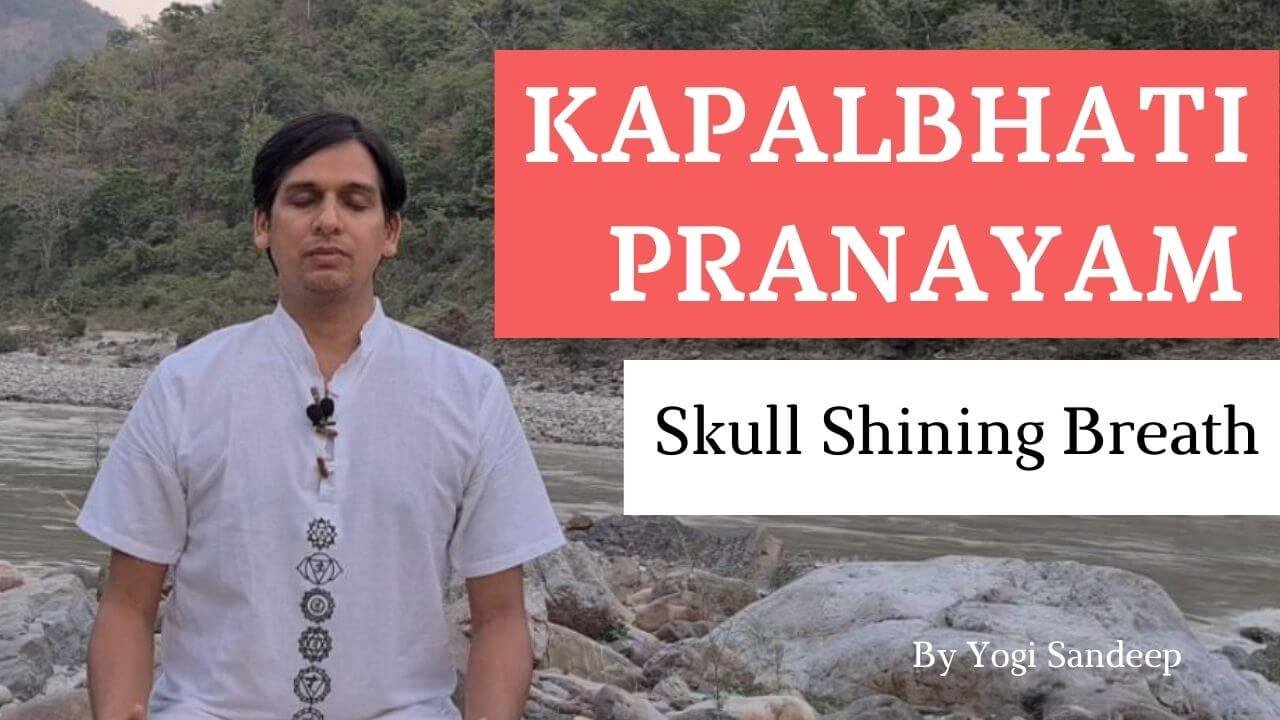Before going into the details let us understand the meaning behind these terms first
- Kapal means skull or forehead
- bhati means shining
- pranayama means breathing technique
Kapalabhati Pranayama is a Yoga Breathing Technique that energises your body and your mind.
What is Kapalbhati?
Kapalbhati is a shat kriya (Yogic Cleansing), which tells us in simple terms that it is a process which will clear out toxins from our body and help us remain healthy. To break it down, 'Kapalbhati' comes from the word 'Kapal' which means forehead and 'Bhati' which means 'to shine',lighting, glowing or illuminating.
According to Grand Samhita - Ancient Text on Hatha Yoga, Kapalbhati is the most important in the process of Shatkarma (shatkriya)- Six Purification Technique. Kapalbhati Pranayama is also known as The Skull Shining Breathing Technique because experts say that it has very advantageous effects on physiological aspects of the body and mind. People claim that this exercise can reap many rewards with facial glow and overall health of the skin as well.
It is known to be an extremely amazing breathing activity that assists you with getting in shape as well as brings your whole framework into an ideal equilibrium. While breathing out most of the toxins are also released from the body and this is the basic framework of the coordinated breathing activity.
Types of kapalbhati
- Vatkrama- It is a practice similar to the Pranayama technique of Bhastrika, except that exhalation is active while inhalation is passive, the opposite of normal breathing. exhalation is active while inhalation is passive, the opposite of normal breathing.
- Vyutkrama- It is aa practice similar to Jala neti, it involves sniffing water through the nostrils and letting it flow down into the mouth, and then spitting it out.
- Sheetkram- It can be considered the reverse of Vyutkrama kapalabhati, in which water is taken through the mouth and expelled through the nose.
How to practice Kapalabhati? - Kapalbhati Steps
- Sit comfortably with your back and spine erect.
- Place your hands on the knees with palms facing upwards.
- Inhale deeply.
- While exhaling you need to pull your stomach. Pull your navel back towards the spine but only as much as you comfortably can.
- You may feel the abdominal muscles contract on your stomach.
- Now relax. As you relax, breath will automatically flow into your lungs.
- Take around twenty breaths to complete one session of KapalBhati Pranayama.
- After this one session of KapalBhati Pranayama, feel your body getting relaxed and try to notice any changes that you can.
- Do two more sessions of KapalBhati Pranayama.
Kapalbhati for beginners
Beginners can begin by doing the Kapal Bhati twice a day for three rounds of 10-20 breaths each. It can be expanded to 30-40 counts over time.
Some Important Points
- The exhalation in Kapalbhati Pranayama is active and forceful. Try to really throw your breath out.
- No need to focus too much on inhalation. As soon as you relax your abdominal muscles, inhalation will happen naturally.
- Always be aware while breathing air out.
- Always practise on an empty stomach in a place you are comfortable.
- The key is to relax and be comfortable with your body and your surroundings.
Kapalbhati Pranayama benefits
- Improve the rate of metabolism, helping in better digestion and weight loss
- Helps reduce belly fat
- Improves blood circulation and brings glow to the face
- Improves functioning of digestive tract, absorption, and adsorption of nutrients
- Clears the nadis (energy channels)
- Rejuvenates the nervous system and enriches brain cells
- Results in a concentrated and focussed mind.
- Focuses on abdominal organs so it is very beneficial to people with diabetes
Kapalbhati Pranayama precautions
Avoid practicing this breathing technique if you have an artificial pacemaker or stent, epilepsy, hernia, backache due to slip disc, or have recently undergone abdominal surgery.
Only practice under a well trained yoga teacher, and people with high blood pressure should first consult with their respective experts.
Women should not practice Skull Shining Breathing technique during and shortly after pregnancy as well as during menstruation as it involves vigorous abdominal squeezes.
People with hypertension and heart problems should practice this breathing technique only under a yoga expert's guidance.
Pranayama Course for Beginners
- Ancient Indian Yogic breathing techniques
- 5 Pranayams | Techniques | Benefits | Contraindications of each type of yogic technique
Kapalbhati Pranayama FAQs
How much time one should do Kapalbhati?
Kapalbhati is a very beneficial practice, however, one must avoid doing it more than 3 times a day. It is advisable for beginners to not stress themselves too much and only seasoned meditators should push themselves beyond this number.
Too much of anything can be harmful, and kapalbhati is an advanced form of spiritual yogic tool, so a little caution must be maintained and done in moderation under proper guidance.
Can we do Kapalbhati in the evening?
You can practise kapalbhati pranayama in the morning or evening, but it's best to do it on an empty stomach. Patients with high blood pressure should practise kapalbhati slowly.
Can I do Kapalbhati sitting on a chair?
Kapalbhati can also be done while sitting on a chair. It removes toxins from the body, keeps the mind busy, strengthens the respiratory system, keeps the mind quiet (which is very beneficial with asthma), strengthens the digestive system, and reduces gas, constipation, and urinary difficulties.
Can I do pranayama before sleeping?
Kapalbhati Pranayama is a yoga technique that can help you overcome any sleeping problems you may be having and improve the quality of your sleep. You can practice kapalbhati at night on empty stomach.





Author | Yogi Sandeep
Born in Rishikesh in the foothills of the Himalayas, into a traditional family where yoga/Vedic tradition has been the way of life for generations.
Yogi Sandeep is a world-traveling yoga teacher and founder of the yoga school Raj Yoga Rishikesh. His teachings have helped many from all over the world.
He is an E-RYT500 Teacher (Certified by YogaAlliance), a Master in Yoga from University in India, and has over a decade of experience in yoga teaching. He conducts yoga teacher training, various yoga courses, and yoga retreats in Rishikesh, India.
He has been traveling around the world and sharing this beautiful knowledge of his passion for body and mind work. His simple and contemporary style of delivering deep yogic philosophy, meditation, and hatha yoga concepts endears him to his students.